The cultivation of Grapes in India is a popular agribusiness. The cultivation of Grapes can be very profitable if it is maintained properly. In India, Grapes are cultivated commercially throughout the year as members of the Vitaceae family. Tropical, sub-tropical, and mild-tropical climates are suitable for growing it. Let’s check out high yield hybrid Grapes varieties in India.
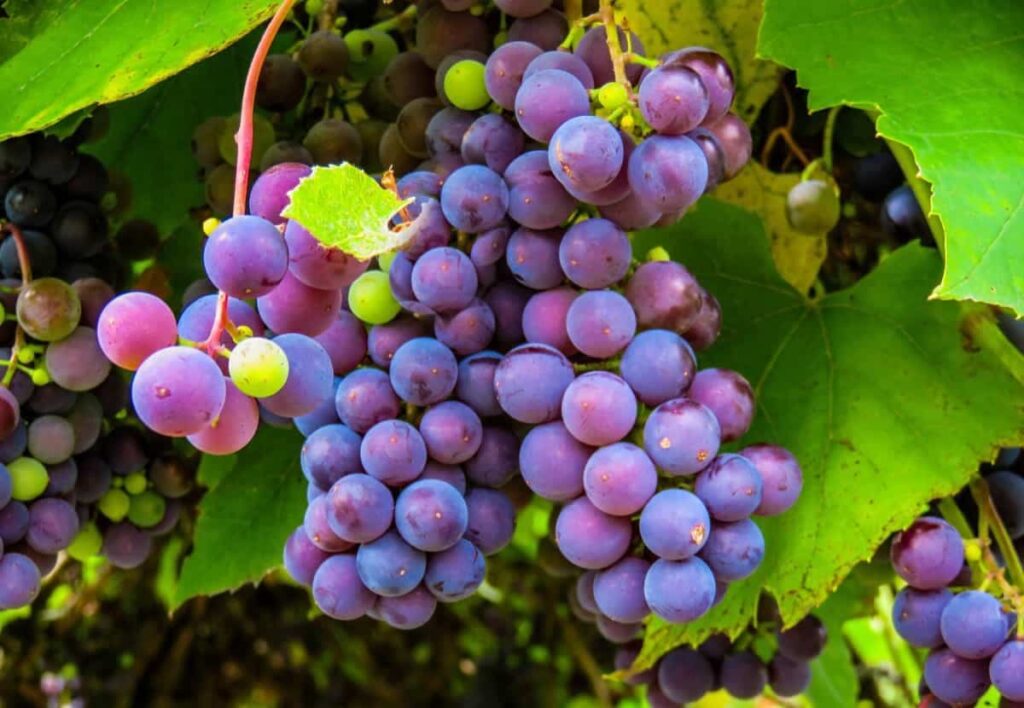
The crop is grown across peninsular India, from Punjab, Madhya Pradesh, Haryana, J & K, and Mizoram to Maharashtra, Karnataka, Tamil Nadu, Andhra Pradesh, and Kerala. Regarding total production, Maharashtra and Tamil Nadu are the two largest contributors. Grape production in India ranks twelfth in the world. In India, most Grape production is consumed. 17 to 20% is used to produce raisins, 1.5 % is used to produce wine, and 0.5 % is used to make juice.
Maharashtra leads the way with an 81.22 % share in Grape production in India. In contrast, a negligible amount of Grapes are used for juice production. Maharashtra’s farmers cultivate Thompson seedless and its clones to make raisins or table Grapes. The high susceptibility of these varieties to fungal diseases increases plant protection costs. Consequently, Grapes suffer losses of 8% to 16% after harvest. Juice-making is an excellent option to minimize post-harvest losses.
Soil and climatic conditions required for Grapes cultivation
Mediterranean climates are ideal for Grape growing. A vine’s vegetative growth occurs from April to September, and its fruit development occurs from October to March under South Indian conditions. Temperatures above 10°C to 40°C affect yield and quality. Humidity and cloudy weather invite many fungal diseases, as well as lowering the TSS: Acid ratio.
Grapes are capable of adapting to a wide range of soil conditions. Nevertheless, the highest yields and qualities are achieved on fertile soils with a pH between 6.5 and 8.5, a level of organic carbon above 1.0%, no lime, and a medium water retention capacity. Therefore, early and medium yields are harvested on medium soils with high total soluble solids (TSS).
High yield hybrid Grapes varieties in India
Various Grapes grew under different soil and climatic conditions across India’s dry, hot and tropical regions. Thomson Seedless and its mutants, Bangalore Blue and Anab-e-Shahi, are India’s major grown types of Grapes. Along with these normal varieties below mentioned hybrid varieties are also cultivated widely throughout India.
In case you missed it: High-yield Hybrid Papaya Varieties in India: How to Grow, Fertilizers, Pests, and Diseases
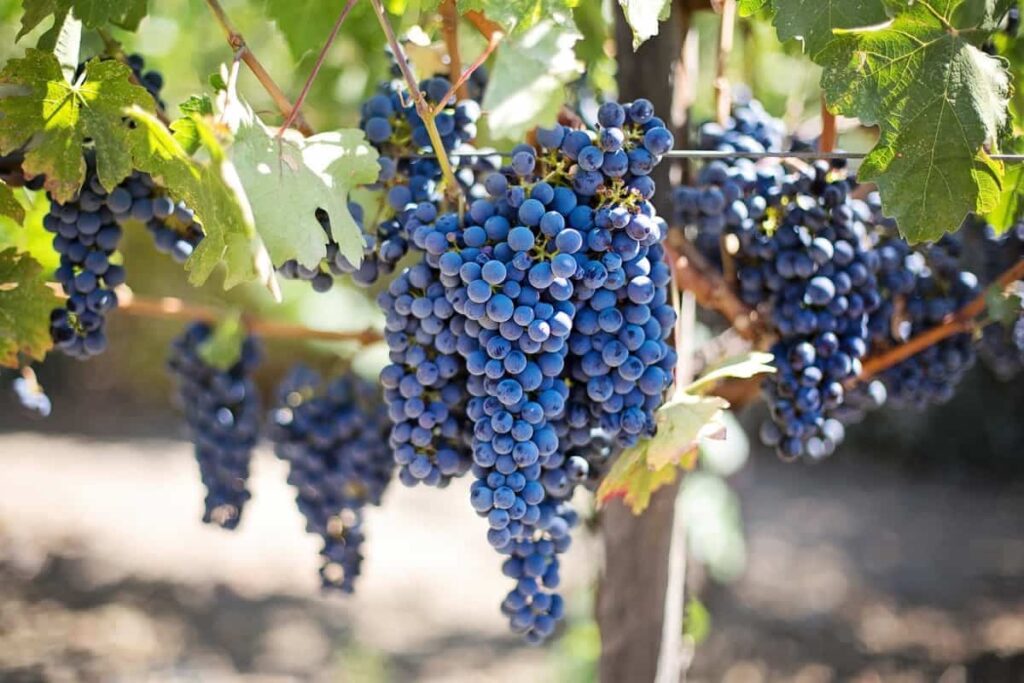
Arka Shweta
Anab-E-Shahi and Thompson Seedless cultivars were crossed to produce Arka Shweta. It produces ovate, pale yellow-colored, and seedless Grapes. In addition, the Grape variety is famous worldwide for its table or direct consumption qualities. As a result, it is in high demand in international markets. Per acre, the average yield is 10.7 tons.
Arka Neel Mani
This hybrid is introduced by a cross between Black Champa and Thompson Seedless. Fruits are black seedless with crisp pulp that contains 20 to 22% of total soluble solids (TSS), and this variety is anthracnose-tolerant. On average, 11.5 tons are produced per acre. In addition to being suitable for wine-making, it is also suitable for table use.
Arka Kanchan
This Grape variety is developed by a cross between Anab-E- Shahi, and Queen of the Vineyard. There is a rich flavor to the golden-green berries of Arka Kanchan. While these aromatic Grapes are extensively used in wine production, they are also used for table purposes.
The golden yellow berries are seeded, ellipsoidal to oblong, and have a pleasant ‘Muscat’ flavor. This variety’s total soluble solids (TSS) are 19 to 22%, making it suitable for wine-making and table use. Despite its high yield potential, this variety has poor keeping qualities. There is an average yield of 13 tons per acre.
Arka Shyam
It is developed by crossing between ‘Bangalore blue’ and ‘Black Champa. Berry size ranges from medium to large, shiny black, spherical to ovoid, seeded, with a mild flavor. Anthracnose is not a problem for this variety. In addition to being suitable for wine-making, it is also suitable for table use. There is an average yield of 10.2 tons per acre.
Arkavati
Arkavati Grapes are yellow-green and seedless. Black Champa and Thompson seedless are crossbred to produce this variety. The hybrid variety is seedless, and it produces good raisins. The Arkavati variety is an indigenous variety used in raisin and wine production. On average, 9.8 tons per acre are produced.
In case you missed it: High Yield Hybrid Mango Varieties in India: State Wise Growing Guide
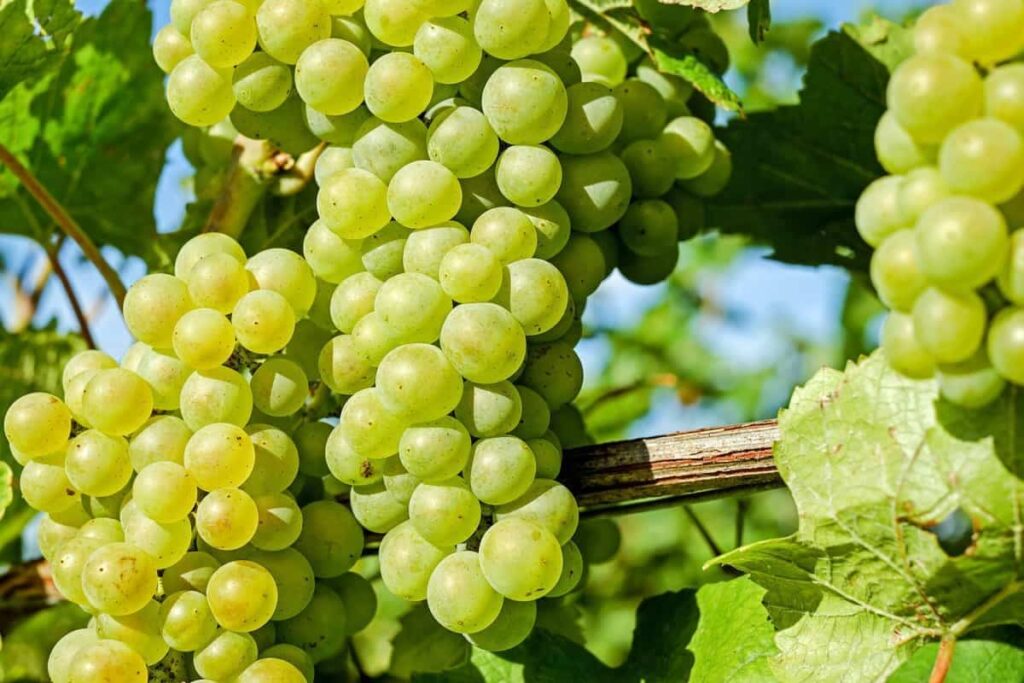
Arka Trishna
A hybrid variety developed by crossing Bangalore Blue and Convent Large Black. With 22 to 23% total soluble solids (TSS), the berries are deep tan, round to oblong, and have a deep tan color. Anthracnose and downy mildew are not a problem for this variety. There is an average yield of 10.5 tons per acre. For wine-making, it is a good variety.
Arka Soma
Anab-E-Shahi was crossed with the Queen of Vineyards to develop this hybrid variety. Its berries are greenish-yellow and oblong to round. Approximately 20 to 21% of the total soluble solids (TSS) are in the pulp, which is meaty and has a muscat flavor. It is resistant to anthracnose, powdery mildew, and downy mildew. An average yield of 16 tons per acre is achieved. It can be used to prepare white dessert wines.
Arka Krishna
The plant is a cross between Black Champa and Thompson Seedless. Berries are round to oblong, dark-colored, seedless, and contain 20 to 21% total soluble solids (TSS). There is an average yield of 13.5 tons per acre. For juice production, the variety is suitable.
Arka Chitra
This hybrid variety is a cross between Angur Kalan and Anab-E-Shahi. In addition to being golden yellow, the berries are slightly elongated and have 20 to 21% of total soluble solids (TSS). Powdery mildew is not a problem for this hybrid variety. An average yield of 15.5 tons per acre is achieved. The berries are very attractive, making them suitable for table use.
Arka Majestic
This variety is developed by a cross between Angur Kalan and Black Champa. A deep tan color, uniform shape, roundness, and 18 to 20% soluble solids are all characteristics of the berries. Anthracnose tolerance is high in this variety. On average, 15.5 tons of Grapes are produced per acre. It is a hybrid variety with good export potential.
Arka Hans
This hybrid variety is a cross between Bangalore Blue and Anab-E- Shahi. Yellowish-green berries are ellipsoidal, spherical, seeded, and have a pleasant flavor. This hybrid has a total soluble solids (TSS) content of 18 to 21% and is commonly used for wine-making. An average yield of 14 tons per acre is achieved.
Pusa Seedless
Thompson Seedless made this selection. Although its berries are more elongated than its parent Thompson Seedless, most characters are similar. The berries’ total soluble solids (TSS) range from 22 to 24%. In addition to being suitable for table use, it can also be used for making raisins. There is an average yield of 10.2 tons per acre.
In case you missed it: High Yield Hybrid Paddy/Rice Varieties in India: For Rabi and Kharif Seasons
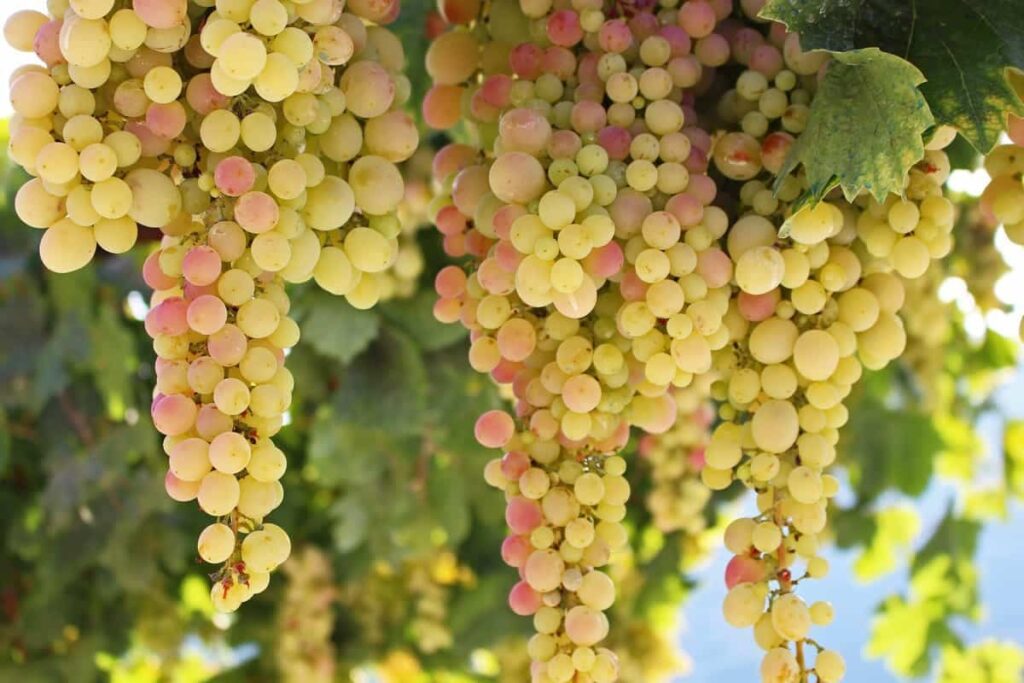
Beauty Seedless
It was introduced by this Division from California, USA, and was evaluated and recommended for commercial cultivation in north India. By the end of May, the berries are ripe. The vine is medium in vigor; the bunches are medium to large, long-shouldered, and compact with blueish-black colored, spherical, medium-sized berries. Bears prolifically but is not very good at storing.
Pusa Navrang
This hybrid was created by crossing Madeleine Angevine with Rubired. Red pigment is present in the peel and pulp of this early ripening variety (1st week of June). The bunch is loose and medium-sized with round and medium-sized berries, and total soluble solids (TSS) range from 18-20%. It is ideal for the production of colored juices and wines and Anthracnose disease-resistant
Pusa Urvashi
Developed from a cross between Hur and Beauty Seedless, this hybrid variety has a high yield. This variety ripens early during the first week of June and is a basal bearer. Greenish-yellow berries are seedless and loosely packed in a medium-sized bunch. Its total soluble solids (TSS) vary between 20 and 22% in berries. It is suitable for table purposes and raisin making.
Pusa Aditi
BanquiAbyad and Perlette are the parents of this hybrid. Fruit is early maturing (1st week of June), seedless, yellowish-green in color, and has a solid pulp with a 19.3% total soluble solids (TSS) content. It is a spur-pruned variety with moderate vigorous growth. In addition to being resistant to anthracnose, it is also resistant to powdery mildew. The bunches and berries of Grapes are GA3-responsive. In addition to being good for table purposes, the fruits can also be used for making juice. Approximately 6 to 7 tons of Grapes are produced per acre on average.
Pusa Trishar
It is a three-way cross hybrid between (Hur x Bharat Early) x Beauty Seedless. It is semi-vigorous and spur-pruned, is early maturing, is suitable for subtropical conditions, and has moderate tolerance to anthracnose, powdery mildew, and termites. By the 10th of June, it will be fully mature.
The berries are round in shape and yellowish-green in color. They contain 18.4% total soluble solids (TSS) and have a firm pulp. Grape bunches and berries are GA3 responsive. In addition to being good for table use, the fruits are also good for making juice. A typical yield per acre is six to seven tons.
Pusa Swarnika
The hybrid was created by crossing Hur with Cardinal. It matures early with large, round, golden-yellow berries with firm pulp. These sweet berries contain 20 to 22% of total soluble solids (TSS). The berries are about 15+ mm in diameter and have natural loose bunches. Clusters are medium in size; the average bunch weight is 409 grams, and the bunch length is 20 cm.
The fruit is an early maturing variety, ready for harvest 75 and 80 days after full bloom. On the head system, mature vineyards of 6 to 8 years old typically produce 3 to 4 tonnes of fruit per acre. Powdery mildew and anthracnose are not a problem for this hybrid. Hybrids are good for table use, juice production, and Munnakka preparation.
In case you missed it: High Yield Hybrid Cotton Varieties in India – For Rabi, and Kaharif Seasons
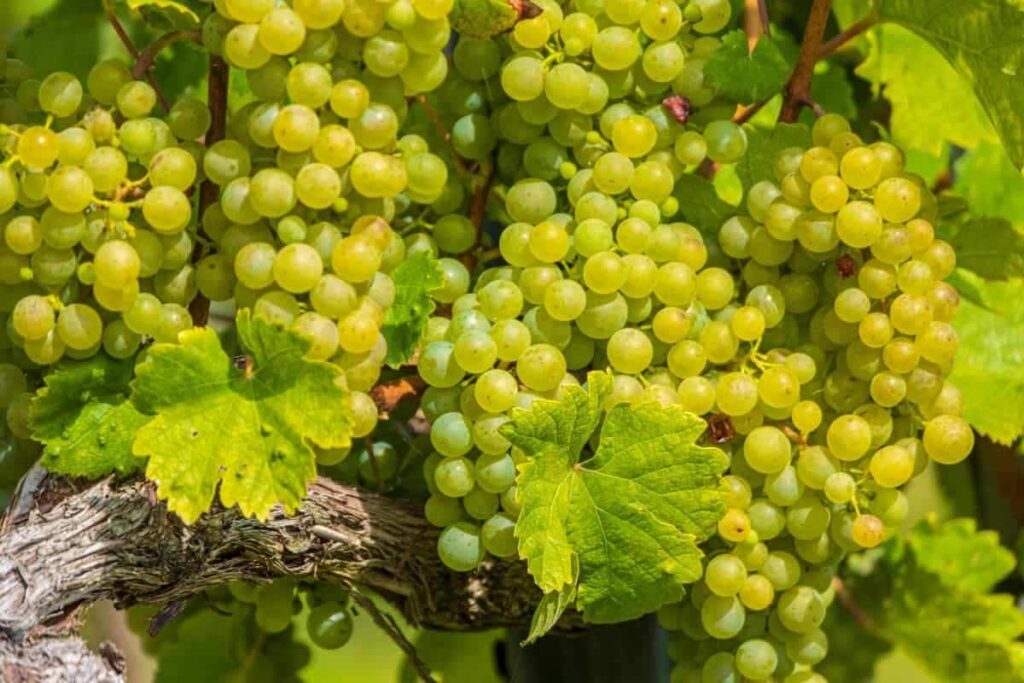
Pusa Purple Seedless
It is a cross between Pearl of Casaba and Beauty Seedless, raised through embryo rescue. Under the subtropical region, it is an extra-early berry ripening variety (75-80 days after full bloom). It produces seedless, purple-colored, medium-sized, and pulpy berries. The TSS (total soluble solids) of the berries is 22%, with an excellent ratio of TSS to acid in the third week of May. On a Kniffin training system (5-year-old vine), it yields 8.60 kg.
ARI-516
The hybrid variety ARI-516 was developed by crossing two species from the same genus — the Catawba variety of Vitis labrusca and the Beauty seedless variety of Vitis vinifera. Tamil Nadu, Maharashtra, Punjab, and Telangana are the states recommended for cultivation. Due to its moderate resistance to a majority of fungal diseases, its cost of production is lower. One of the salient features of ARI-516 is its evenly maturing character and its long cylindrical medium-sized fruit bunches.
Furthermore, it has small to medium bluish blackberries with a single seed, which are sweet, with a TSS (Total soluble solids) of 20 to 22% and a musky flavor of about 65-70%. Approximately 15-20 tons of berries are produced per acre. This plant is resistant to downy and powdery mildew diseases and anthracnose disease, a group of fungal diseases that affect many plants in humid climates.
Bangalore blue
Vinifera and labrusca Grapes are supposed to be the parent plants of Bangalore blue Grapes. Small in size, oblong in shape, and with soft skin, Bangalore blue Grapes have a distinct foxy flavor and are typically dark purple with a blend of sweet and sour flavors. With about 16 to 18 percent TSS, the juice is purple-hued and pleasantly flavored. In addition to making juice, wine, jams, and jellies, these Grapes also have good keeping qualities.
In Bangalore and the surrounding areas, the red loamy soil mixed with sand and the daytime temperature of 35°C to 37°C and the nighttime temperature of 12°C to 15°C is conducive to the cultivation of blue Grapes. The harvesting season runs from January to March and from June to December. There is an average yield of 16 to 24 tons per acre. A majority of the production is consumed as table Grapes. Nearly 2.5% of the produce is exported to the Middle East and Europe.
Season of Grape growing
India’s most lucrative farming industry is Grape growing. The cultivation of Grapes is called Viticulture. In India, Grapes are generally grown from October until January. The spring season is the season of Grapes in India because it is the most favorable season for Grape production. Occasionally, Grapes are planted during June-July when rainstorms are late. Monsoon planting is avoided to keep young development safe from infections.
The trenches were opened for planting in the N-S direction. Approximately 60 to 75 cm wide is the size of tranches. Afterward, these trenches were filled with farmyard manure, natural fertilizers, natural blends, neem cakes, etc. Separating for planting is kept up with relying upon soil type, assortment, and strategy for preparing. For each acre of land, the distance between two columns might be 2 to 3 m, while the distance between plants inside a line will be half that, accommodating about 800 to 2000 plants.
In case you missed it: High Yield Hybrid Chilli Varieties in India: For Rabi, Kharif, Winter, Summer, and Rainy Seasons
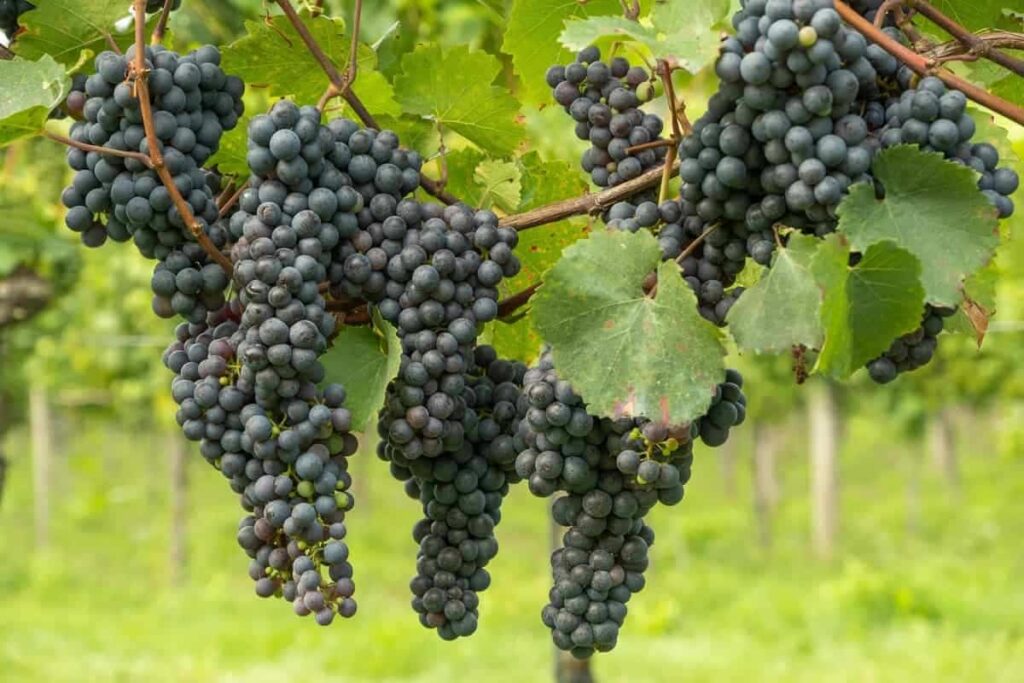
States popular for Grape cultivation and list of varieties cultivating in different states
| States | Varieties cultivated |
| Haryana, Punjab, Delhi, Western Uttar Pradesh, Rajasthan | Thompson Seedless, Perlette, Beauty Seedless, Anab-e-Shahi, Black Hamburg, Black Prince, Dakh, Foster’s seedling, Kandhari, Khalili, Pandhari Sahebi, Watham Cross, Pusa Seedless, Hur, Black Muscat, Early Muscat, Banquiabyad, Cardinal, Kairon |
| Telangana & Rayalseema regions of Andhra PradeshNasik, Pune, Sholapur, Satara, Sangli, Bhir, Aurangabad, and Ahmednagar districts of MaharashtraBijapur, Gulbarga, Raichur, and Bellary districts of Karnataka | Anab-e-Shahi, Thompson Seedless, Cheema Sahebi, Pandari Sahebi, Gulabi, Bhokri, Kali Sahebi, Sonaka & Tas-A-Ganesh(clones of Thompson seedless). |
| Madurai, Salem, and Coimbatore districts of Tamil Nadu, Bangalore, Kolar, Mysore & Tumkur districts of Karnataka | Bhokri, Anab-e-Shahi, Gulabi, Bangalore Blue, Black Champa, Convent Large Black, Angur Kalan, Taifi Rosovi, Coarna Resia, Queen of the vineyard, Kandhari, Black Prince, Muscat, Pachadraksha |
Harvesting Grapes
Every year, nearly one million tons of Grapes are harvested in India. A variety and clone type determine the harvest period, and while berries start ripening doesn’t mean they are ready for harvesting, growers should keep this in mind. When the color changes near the tip and the fruit tastes sweet, almost all varieties should be harvested. In the hot tropical region, Anab-e-Shahi or Thompson Seedless and its hybrids contribute a large portion and are harvested during March-April.
In the mid-tropics, it is harvested from July to December. Similarly, Bangalore Blue’s harvest occurs from Jan-Mar and June-Dec, whereas Gulabi’s occurs from Jan-Mar and June-Dec. Remove the decayed, deformed, smashed, or undersized berries from clusters a day before harvesting. Morning is the best time to harvest them until the temperature rises over 20°C.
Conclusion
Grape cultivation in India is a popular agribusiness in some states. Grape cultivation can be very profitable if maintained well. By cultivating hybrid Grape varieties, you can get higher yields than normal varieties.
- Sheep Farming Business Plan for Beginners
- Aquaponic Farming at Home: A Step-By-Step Guide
- Profitable Village Farming Business Ideas in 2024
- High-Yield Aquaculture: Fast-Growing Fish for Farming
- Effective Fish Pond Construction Techniques for Beginners
- Irrigation and Water Management in Pineapple Farming
- Blossom to Harvest: Mastering Flowering and Pollination in Papaya Farming
- Pig Fattening Essentials: From Selection to Sale for Beginners
- Raising Wagyu Cattle: A Complete Guide for Premium Beef Production
- Soil Types and Their Water Holding Capacity
- Optimizing Irrigation Schedules for Coconut Groves for Enhanced Yield
- Espresso Your Garden: Coffee Grounds for Healthier Acid-Loving Plants
- The Best Soil Mix for Snake Plants: How to Mix Your Own Snake Plant Soil
- Green Thumb Success: Expert Tips for Cultivating Greenhouse Beans All Year Round
- Bloom All Year Round: The Ultimate Guide to Indoor Hyacinth Care
- Eco-Friendly Gardening: How to Make Liquid Fertilizer from Kitchen Waste
- Ultimate Guide to Grow Anise in Pots: Explore Seed Propagation to Harvesting
- Guide to Raising Chester White Pigs: Discover Breed Facts to Growth Management
- Mastering the Elegance: The Ultimate Guide to Weeping Cherry Tree Care, Planting, and Maintenance
- Ultimate Guide to Planting Garlic in Grow Bags: Growing Strategies for Beginners
- How to Fix Spider Plant Leaf-Related Problems: Natural and Organic Remedies
- 10 Reasons Why Your Tulsi Plant is Shedding Leaves: Home Remedies and Solutions
- Optimizing Growth and Yield: The Advantages of Palm Bunch Ash Fertilizer
- Utilizing Neem Oil Extract as a Natural Pesticide for Hydrangea
- From Soil to Harvest: Various Ways in Which Farmers Can Use AI Tools
- Steps to Encourage and Induce Citrus Flowers: A Comprehensive Guide
- How to Fix Snake Plant Leaf-Related Issues: Natural and Organic Remedies
- Transform Your Garden into a Fragrant Oasis with Raat Ki Rani (Night Blooming Jasmine)
- Discover the Ideal Chicken Breeds for Philippine Farms
- How to Create a Poultry Egg Farm Business Plan for Profits
- Grow Lemon Cucumbers Like a Pro: Insider Techniques for Bountiful Yields
- Ultimate Guide to Caring for Your Pink Princess Philodendron: Tips for Thriving Variegation
- Areca Nut Profit Per Acre: Calculating Yield and Cost of Cultivation
- How Kaveri Chicken is Becoming a More Profitable Breed in Indian Backyards
- Transform Your Barn: 9 Steps to Convert a Horse Stall into a Chicken Coop
- Exploring Suffolk Sheep Disadvantages with Limitations and Challenges
